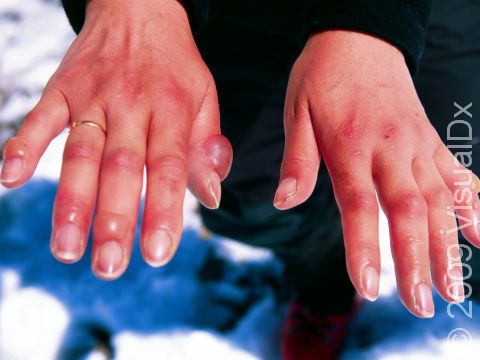Frostbite, First Aid
Frostbite is freezing of the skin that occurs due to exposure to cold temperatures. Frostbite often starts out with mild symptoms and can progress and become quite severe and even limb-threatening.
Mild frostbite is considered skin that is either red and painful, or white and numb. Severe frostbite includes blistering skin, hard skin (due to frozen bone and blood vessels), and possibly gangrene (tissue that has died and turned black, after blood vessels became frozen).
Frostbite is often associated with hypothermia.
First Aid Guide
In the case of mild frostbite, the following measures should be taken:
- Move the person someplace that is warmer.
- Remove clothing from the affected area.
- Rewarm the affected area until sensation in the skin has returned and the skin is soft (for at least 30 minutes). Rewarming of frostbitten skin is typically accompanied by pain, swelling, and color change.
- To rewarm an extremity, place the limb in a bath of warm water (ie, 100°–105° F). Continue to circulate and refresh the warm water.
- To rewarm an area that cannot be soaked in a bath of water, apply a warm compress. (Ensure that the compress is warm but not hot.)
- Apply a clean (sterile, if possible), dry dressing to the affected area.
- Re-cover the affected area with dry clothing to keep it warm.
- Obtain medical help.
Note:
- Frostbitten areas, once thawed, should be moved as little as possible.
- Do not massage the affected area to attempt to rewarm it.
- Avoid disturbing any blisters or skin that has become gangrenous.
- Do not use direct heat (hair dryers, heating pads, etc) to rewarm the affected area.
- If there is potential for refreezing of an area, do not attempt to thaw, as thawing followed by refreezing can cause even more extensive damage to the area.
When a person has both frostbite and hypothermia, contact emergency medical services, and give first aid for the hypothermia followed by first aid for the frostbite.
First aid measures for hypothermia are as follows:
- Check the person’s ABCs: open the airway, and check breathing and circulation.
- Move the person to a warmer area, and replace any wet or constricting clothes with loose, dry clothing.
- To rewarm the person:
- Cover the person completely with foil or a space blanket, or use your own body heat to help warm him/her.
- Use warm compresses on the neck, chest, and groin.
- Give warm, sweet fluids. (Any fluids given should be nonalcoholic, as alcohol interferes with the blood’s circulation.)
Who's At Risk?
Frostbite occurs most often to those exposed to extreme cold, so people who participate in cold-weather outdoor activities or live in or travel to cold climates are most at risk. Frostbite can also occur in those exposed to high winds, those with poor circulation, those in cramped positions who have tight-fitting clothing or boots, and those suffering from fatigue. Additionally, certain diseases and medications, alcohol consumption, and smoking increase risk for frostbite.
Signs & Symptoms
Frostbite most often occurs on skin exposed to cold, such as on the face or ears, and on extremities, such as fingers and toes.
Skin that is mildly frostbitten may look either reddened or white. When frostbite becomes more severe, the skin may appear blistered and possibly blackened. In severe frostbite, the skin typically feels hard to the touch.
Treatments
The physician will first work to rewarm the affected area(s) while managing the pain associated with rewarming frostbitten skin. The area will be dressed and elevated to protect the sensitive skin from further damage.
In the case that the area becomes infected, an antibiotic will be given, and surgical management may be needed.
Follow-up care with a physician, physical therapist, and rehabilitation therapist is very important and may be long term.
Visit Urgency
Seek medical care for any form of frostbite. For mild frostbite, perform the above self-care measures and then obtain medical help. For severe frostbite, call emergency medical services.
Trusted Links
Last modified on October 6th, 2022 at 2:46 pm

Not sure what to look for?
Try our new Rash and Skin Condition Finder
